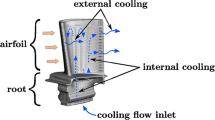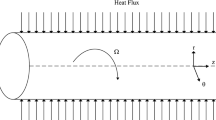Abstract
In the present study, the fully developed turbulent secondary flows inside rotating square-upstream section and rectangular downstream section oriented at several angles with axis rotation are numerically simulated using the low Reynolds Non-linear \( k - \omega \), \( k - \varepsilon \) Reynolds-Stress Model (RSM), and Large Eddy Simulation (LES) models. The two flat walls are heated (leading and trailing sides), while the outer wall and the splitter plate are thermally insulated. The simulation has been done at Re = 36,000 with different rotation numbers from Ro = −0.4 to Ro = 0.4, where negative Ro values refer to counter-clock wise and positive Ro values refer to clock wise sense of rotation. This enables to investigate the effects on the thermal development of the rotation numbers. The effects of minor modifications, in cross section area at the bend exit, on thermal development, under rotating conditions, can also be explored. The interactions between secondary flows and separation lead to very complex flow patterns. To accurately simulate these flows and heat transfer, both refined turbulence models and higher-order numerical schemes are indispensable for turbine designers to improve the cooling performance. Previous studies have shown that the flow and heat transfer features through curved bends, even with a moderate curvature, cannot be accurately simulated. It is the conventional belief and practice that the usage of a proper turbulence model and a reliable numerical method for achieving accurate computations. It is shown that the present RSM model produces satisfactory predictions of the flow development inside the sharp U-bend comparing with the experiments (Iacovides et al. 2006). In the present study, three turbulence models are used to predict Nusselt number distribution. The results were further compared with the LES computations and discussed the difference between the turbulence models and the LES as well.






















Similar content being viewed by others
Abbreviations
- a, c:
-
Weighted average coefficients
- \( C_{i} (i = 1\sim 9) \) :
-
Turbulence modeling constants in Eq. 3
- D :
-
Hydraulic diameter
- f k :
-
Coriolis force
- k :
-
Turbulence kinetic energy
- LES:
-
Large eddy simulation
- M t :
-
Turbulent mach number
- Nu :
-
Local nusselt number
- P :
-
Mean pressure
- P k :
-
Generation rate of \( \overline{{u_{i} u_{j} }} \)
- Pr:
-
Fluid Prandtl number
- R c :
-
Radius of curvature of U-bend to the midpoint of curved duct
- Ro:
-
Rossby number (rotation number) (ΩD/W b )
- Re:
-
Flow Reynolds number \( \left( { \equiv W_{b} D/v} \right) \)
- R k , R β, R ω :
-
Model constants
- RSM:
-
Reynolds-stress model
- S ij :
-
Deformation tensor
- U :
-
Mean velocity in cross duct direction
- U i :
-
Mean velocity tensor
- \( \overline{{u_{i} u_{j} }} \) :
-
Reynolds stress tensor
- W :
-
Mean velocity in streamwise direction
- W b :
-
Bulk velocity
- x :
-
Crossduct direction
- y :
-
Direction normal to the duct symmetry plane
- z :
-
Streamwise direction
- \( \delta_{ij} \) :
-
Kronecker delta
- εijk :
-
Third order skew-symmetric unit tensor
- \( \omega \) :
-
Specific dissipation rate
- \( \Upomega_{ij} \) :
-
Vorticity tensor
- \( \mu , { }\mu_{\text{t}} \) :
-
Laminar and turbulence viscosity
- \( \alpha_{0} ,\alpha_{0}^{*} ,\beta \) :
-
Model constants
- \( \Upphi \) :
-
Transport variable
- ρ:
-
Density
- ε:
-
Turbulence dissipation
References
Iacovides H, Kounadis D, Launder BE (2006) Experimental study of the thermal development in a rotating squared-ended U-Bend. Power Land, Sea and Air. ASME Turbo Expo GT2006-90846
Iacovides H, Jackson DC, Kelemenis G, Launder BE, Yuan YM (1999) Experiments on local heat transfer in a rotating square-ended U-bend. Int J Heat Fluid Flow 20:302–310
Kelemenis GI (1999) Flow and local thermal measurements in stationary and rotating cooling passages of complex geometries. PhD thesis, Thermodynamics and Fluid Mechanics Division, Department of Mechanical Engineering, UMIST
Ekkad SV, Han JC (1995) Local heat transfer distributions near a sharp 1800 turn of a two-pass smooth square channel using a transient liquid crystal image technique. J Flow Vis Image Process 2:285–297
Cheah SC, Iacovides H, Jackson DC, Ji H, Launder BE (1996) LDA investigation of the flow development through rotating U-ducts. ASME J Turbomachinery 118:590–596
Wagner JH, Jonhson BV, Kopper FC (1991) Heat transfer in rotating serpentine passage with smooth wall. J Turbomachinery 113:321–330
Prakash C, Zercle R (1992) Prediction of turbulent flow and heat transfer in a radially rotating square duct. J Turbomachinery 114(4):835–846
Bo T, Iacovides H, Launder BE (1995) Developing buoyancy turbulent in ducts rotating in orthogonal mode. J Turbomachinery 117(3):474–484
Patankar SV (1980) Numerical heat transfer and fluid flow. McGraw-Hill, New York
Rhie CM, Chow WL (1983) A numerical study of the turbulent flow past an isolated airfoil with trailing edge separation. AIAA J 21:1525–1532
Bo T, Iacovides H, Launder BE (1995) Convective discretization schemes for the turbulence transport equations in flow predictions through sharp U-bends. Int J Num Meth Heat Fluid Flow 5:33–48
Song B, Liu GR, Amano RS (2001) Applications of a higher-order bounded numerical scheme to turbulent flows. Int J Numer Methods Fluids 35:371–394
Hu S-Y, Chi X, Shih TI-P, Bryden KM, Chyu MK, Ames R, Dennis RA (2011) Flow and heat transfer in the tip-turn region of a u-duct under rotating and non-rotating conditions. ASME Proc Turbo Expo 2011, Vancouver, Canada, GT2011-46013
Wilcox DC (1993) Turbulence modeling for CFD, 1st ed
Lilly D (1992) Proposed modification of the germano sub-grid scale closure method. Phys Fluids A 4(3):633–635
Zhu J, Leschziner MA (1988) A local oscillation-damping algorithm for higher-order convection schemes. Comput Meth Appl Mech Eng 67:355–366
Acknowledgments
The original paper was presented at ASME Turbo Expo 2008: Power for Land, Sea, and Air (GT2008). The authors are grateful for ASME for granting a permission of this paper to publish in Heat and Mass Transfer.
Author information
Authors and Affiliations
Corresponding author
Rights and permissions
About this article
Cite this article
Amano, R.S., Lucci, J.M., Guntur, K. et al. Numerical study of the thermal development in a rotating cooling passage. Heat Mass Transfer 48, 1011–1022 (2012). https://doi.org/10.1007/s00231-011-0940-3
Received:
Accepted:
Published:
Issue Date:
DOI: https://doi.org/10.1007/s00231-011-0940-3




